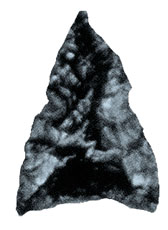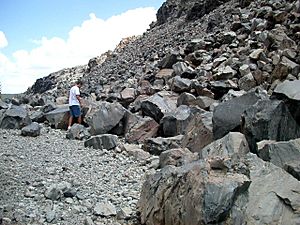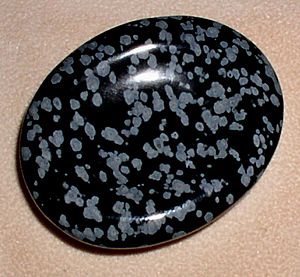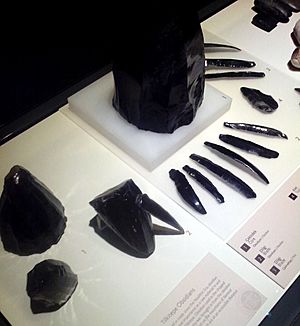Obsidian facts for kids
Quick facts for kids Obsidian |
|
|---|---|
 |
|
| General | |
| Category | Volcanic glass |
| Identification | |
| Color | usually black; sometimes green or brown; rarely yellow, orange, red or blue |
| Fracture | Conchoidal |
| Mohs scale hardness | 5–6 |
| Luster | Vitreous |
| Specific gravity | c. 2.4 |
| Optical properties | Translucent |
| Melting point | 700–1,050 °C (1,292–1,922 °F) |
| Other characteristics | Texture: Smooth; glassy |
Obsidian is a fascinating natural volcanic glass. It forms when hot lava from a volcano cools down very quickly. This fast cooling prevents crystal growth, making it a smooth, glassy rock. Obsidian is a type of igneous rock, which means it comes from volcanic activity. It is full of light elements like silicon and oxygen.
You often find obsidian where rhyolitic lava flows have cooled. This lava is thick and sticky, like very slow honey. Its thickness, combined with quick cooling, stops tiny atoms from forming into crystals. Instead, the lava turns into a natural glass. Obsidian is known for being hard, yet brittle. It breaks with very sharp edges, like glass. Because of this, people have used it for tools and even for special surgical blades.
Contents
How Obsidian Forms
A Roman writer named Pliny the Elder wrote about a volcanic glass called obsidian. He said it was found in Ethiopia by an explorer named Obsidius. This is where the name "obsidian" likely comes from!
Obsidian forms when lava cools down extremely fast. This can happen when hot lava flows out of a volcano and touches cool air or water. It can also form at the edges of thick lava flows or volcanic domes. Because it cools so quickly, the atoms in the lava don't have time to arrange themselves into crystals. This is why obsidian is a glass, not a true mineral. Scientists sometimes call it a mineraloid.
Obsidian is mostly made of silicon dioxide (SiO2), which is also found in granite and rhyolite. Over a very long time, obsidian can slowly change and form tiny mineral crystals, especially if water is present. This means that very old obsidian is quite rare.
Amazing Properties of Obsidian
Obsidian is usually dark, often black or dark brown. This color comes from tiny bits of iron and other elements inside it. Sometimes, it can be green, red, or even blue! Very rarely, you might find almost colorless obsidian.
Some types of obsidian have unique patterns:
- Snowflake obsidian: This black obsidian has white, snowflake-like patterns. These are tiny crystals of a mineral called cristobalite.
- Sheen obsidian: This type has a beautiful golden or silver shine. This happens when tiny gas bubbles are trapped in layers within the rock.
- Fire obsidian: This obsidian shows a rainbow of colors, like a tiny rainbow trapped inside the stone. This effect is caused by super tiny particles of magnetite that create thin-film interference.
- Rainbow obsidian: Found in Mexico, this obsidian has colorful stripes. These stripes are caused by tiny rods of a mineral called hedenbergite.
Where Can You Find Obsidian?

Obsidian is found all over the world, but only in places where there have been volcanoes with rhyolitic eruptions. Some of the countries where you can find obsidian include:
- Argentina
- Canada
- Chile
- Greece
- Iceland
- Italy
- Japan
- Mexico
- New Zealand
- Turkey
- The United States
In the United States, you can find huge obsidian flows that you can even hike on! These are located at places like Newberry Volcano and Medicine Lake Volcano in California. Yellowstone National Park also has a mountainside made of obsidian. Other western states like Arizona, Colorado, and Oregon also have obsidian deposits.
Important ancient sources of obsidian were found on islands like Milos and Lipari in the Mediterranean Sea. In Anatolia (modern-day Turkey), places like Acıgöl and Göllü Dağ volcano were also very important sources in ancient times.
Obsidian Through History

For thousands of years, people have used obsidian. The earliest evidence of its use dates back about 700,000 years ago in places like Kenya. Ancient people quickly learned that obsidian could be shaped into incredibly sharp tools.
Obsidian was very important in Stone Age cultures. Just like flint, it could be carefully broken, or "knapped," to create sharp blades, arrowheads, and other cutting tools. When obsidian breaks, it forms a special curved surface called a conchoidal fracture, which makes its edges extremely sharp. People also polished obsidian to make early mirrors. Today, archaeologists can even use a method called obsidian hydration dating to figure out how old obsidian tools are!
Ancient Tools and Art
In the Neolithic period, people on the island of Lipari became very skilled at making tiny obsidian blades. These blades were traded across long distances, reaching places like Sicily and Croatia. Obsidian from Anatolia (modern-day Turkey) was used in the Middle East as early as 12,500 BC. It was found in ancient cities like Tell Brak, one of the first big cities in Mesopotamia.
Obsidian Around the World
- Europe: Obsidian tools appeared in Europe during the Middle Paleolithic period. The island of Milos was a key source for cultures in and around Greece. People traded obsidian far and wide, showing how valuable it was.
- Middle East and Asia: In the Ubaid period (around 5th millennium BC), people in modern-day Turkey used obsidian to make blades. Ancient Egyptians imported obsidian from nearby regions for tools and decorative items. In Japan, obsidian was mined during the Jōmon period for tools.
- Americas: Pre-Columbian people in Mesoamerica (like the Maya and Aztec) used obsidian extensively. They made tools, decorative objects, and even weapons like the macuahuitl, a wooden sword with sharp obsidian blades. These weapons were very effective. Some Aztec priests used polished obsidian mirrors for special ceremonies, connecting them to their god Tezcatlipoca, whose name means 'Smoking Mirror'. Indigenous people across the Americas traded obsidian over vast distances. Archaeologists can trace where the obsidian came from, helping them understand ancient trade routes.
- Oceania: The Lapita culture in the Pacific Ocean (around 1000 BC) used obsidian tools widely. They traded obsidian over long distances, and these tools were likely seen as symbols of importance or high status. On Rapa Nui, obsidian was used for tools and even for the eyes of their famous Moai statues.
Modern Uses of Obsidian
Obsidian is still used today for several interesting purposes.
Super Sharp Blades
Obsidian can make extremely sharp knives, sometimes called glass knives. Some surgeons use obsidian for special scalpel blades, especially for research animals. These blades can be many times sharper than steel surgical scalpels. An obsidian blade's cutting edge can be as thin as three nanometers! Under a powerful electron microscope, metal blades look jagged, but obsidian blades still look smooth. The main drawback is that obsidian is brittle, meaning it can break more easily than metal.
Beautiful Decorations
Obsidian is also popular for ornamental purposes and as a gemstone. It can look different depending on how it's cut. Sometimes it's jet black, and other times it has a glistening gray shine. Small, rounded pieces of obsidian are sometimes called "Apache tears". Since the 1970s, some high-quality audio turntables have even used obsidian for their bases!
See also
 In Spanish: Obsidiana para niños
In Spanish: Obsidiana para niños
- Apache tears
- Helenite
- Hyaloclastite and tachylite – volcanic glasses with basaltic composition
- Knapping
- Libyan desert glass
- Mayor Island / Tūhua – a source of Māori obsidian tools
- Obsidian hydration dating
- Stone tool
- Vitrophyre
- Yaxchilan Lintel 24 – Ancient carving showing a Maya bloodlet ritual involving a rope with obsidian shards.





